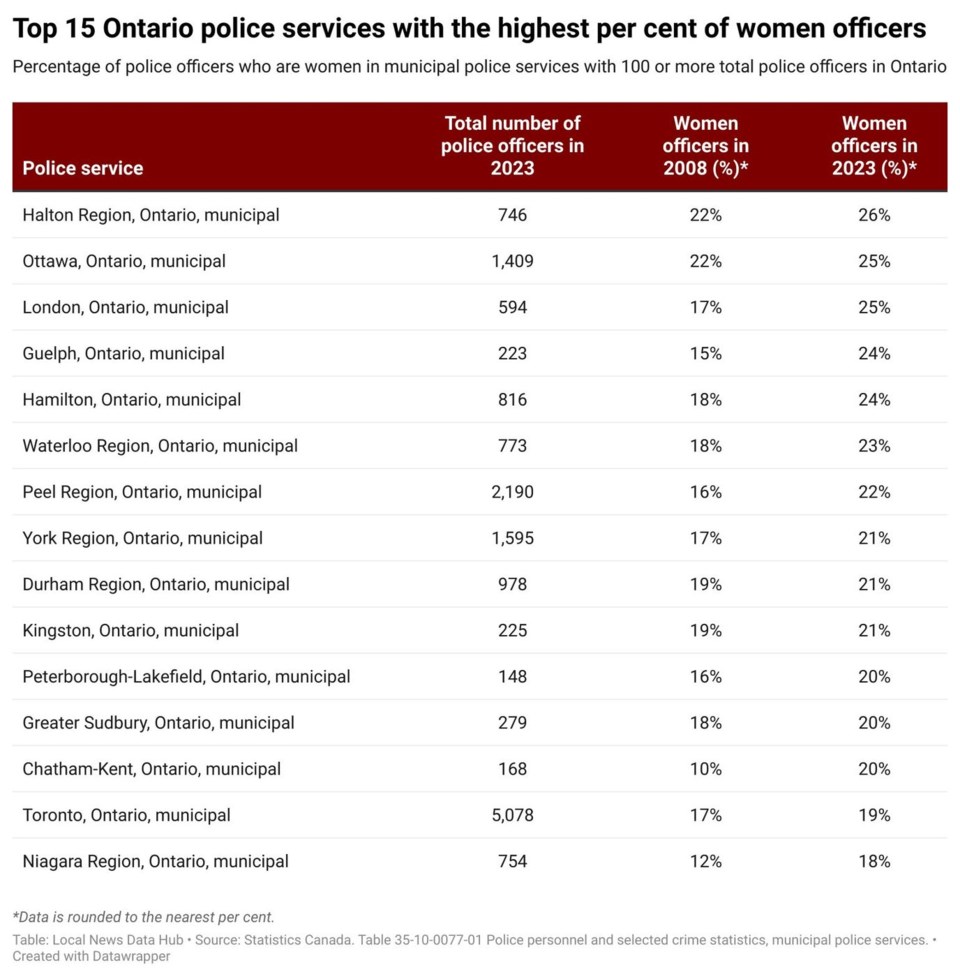LOCAL NEWS DATA HUB — Women police officers remain significantly underrepresented in police services across Ontario despite evidence suggesting they are often preferred by victims of domestic violence or sexual assault, are less likely to use force, and may be better at de-escalating tense situations.
Among the 23 local Ontario police departments with 100 or more officers in 2023, gender diversity was greatest in the Halton Regional Police Service, according to a new analysis by the Local News Data Hub at Toronto Metropolitan University. Even so, only 26 per cent of the 746 uniformed frontline and senior officers who comprise the service’s sworn ranks were women. The next best performers were the municipal police services in Ottawa and London, where 25 per cent of sworn officers were women.
The 30x30 Initiative, a coalition of Canadian and American police agencies and researchers supporting the advancement of women in policing, suggests a group must make up at least 30 per cent of an organization before it can influence its culture.
The underwhelming results of efforts to recruit and retain women in the field come at a time when many argue they are essential to effective policing.
Julie Craddock, who until September was deputy chief of the Sarnia Police Service in southwestern Ontario, said women tend to have the communication skills needed to take the edge off confrontations. Over a 30-year career that included working in recruiting, criminal investigations and as an inspector, she said she relied upon those skills “because I didn't want to end up in a situation (where)...somebody was going to have more physical strength.”
A study by Carleton University researchers that examined the use of force at one large Canadian police service concluded that its women officers were about half as likely as their male counterparts to ever employ force.
Craddock said women officers also play an important role in dealing with victims of sexual assault and intimate partner violence. She insisted, however, they should not be confined to so-called “caring” roles.
“When I started 30 years ago, the women all went into school resource and community engagement and the men did all of the fancy, fun stuff,” she said. “There are a lot of women that want to do homicide investigation and tactical and explosives.”
After identifying the 75 local police departments in Canada with at least 100 sworn officers in 2023, the Data Hub ranked them based on the percentage of women in each service. Across the country, only nine met or surpassed the 30 per cent threshold for gender representation.
The Sarnia Police Service, where Craddock spent 18 months before becoming deputy chief of the Anishinabek Police Service near Sault Ste. Marie, Ont., ranked last among all departments included in the analysis. The proportion of women actually fell to 9.5 per cent in 2023 from 11 per cent in 2008.
The Data Hub based its ranking on personnel data submitted annually by municipal police services to Statistics Canada’s Police Administration Survey. Brianna Jaffray, from the Canadian Center for Justice and Community Safety Statistics at Statistics Canada, confirmed that comparing the survey’s personnel data across jurisdictions and over time was a valid approach. The data also showed that:
- Overall, 23 per cent of sworn officers across Canada were women in 2023, up from four per cent in 1986 when Statistics Canada began collecting data.
- Montreal’s police service had the highest proportion of women officers in its sworn ranks – they accounted for 35 per cent of its 4,507 officers in 2023.
- In addition to the Sarnia Police Service, women were poorly represented in police services in Thunder Bay, Ont., where they made up only 13 per cent of sworn officers in 2023, down from 16 per cent in 2008. Gender representation also declined in the Nishnawbe Aski Police Service, which operates in 34 First Nation communities across northwestern Ontario. Only 12 per cent of officers were women in 2023, down from 15 per cent in 2008.
- Women are notably underrepresented in Ontario’s major police departments. In the 5,078-member Toronto Police Service, the country’s largest local police department, just 19 per cent of sworn officers were women in 2023. They accounted for 21 per cent of the 1,595 officers in the York Regional Police Service and 22 per cent of the 2,190 officers in the Peel Regional Police Service.
The Barrie Police Service and Peel Regional Police Service are among just eight Canadian members of the 30x30 Initiative, which says the “under-representation of women in policing undermines public safety.” Signatories commit to increasing women’s representation among police recruits to 30 per cent by 2030.
Carrie Sanders, a Wilfrid Laurier University criminology professor and co-author of a study that examined how women navigate the “boys’ club” mentality in policing, said in an interview that integrating women isn’t just about boosting numbers. “It's about creating a cultural space of inclusion that allows the women to do well and flourish.”
The research team interviewed 91 women, most of them sworn officers, and Sanders said participants frequently mentioned having to deal with “sexual innuendos being made on the job, or statements that no one should be expected to have to listen to or learn to laugh off, in order to feel like they're just part of the club.”
The study, published in a 2022 issue of Feminist Criminology, includes one officer’s description of being left alone to de-escalate a situation. Her backup said he wanted “to make sure you can handle yourself, be one of us.” Another interview subject observed that “you’re a member of the brotherhood unless you challenge the men.” Researchers also heard that being accepted into the boy’s club meant “not be(ing) as friendly to the other women.”
Recent history suggests changing police culture remains a work in progress for many services. In 2020, for instance, the Human Rights Tribunal of Ontario ordered the Toronto Police Service Board to develop new human rights policies and training programs after finding that a woman officer had suffered years of sexual harassment by colleagues.
Toronto Police Service staff superintendent Pauline Gray, who is retiring as head of detective operations after a 36-year career in policing, said when she was hired in the 1980s women weren’t expected to become senior officers. “Representation matters – if you see it, you can be it,” she said, noting that there are more role models today. Across the country, the number of women in top positions increased to 18 per cent in 2023, up from 1.25 per cent three decades earlier, according to Statistics Canada.
That said, getting women to apply for jobs in policing and stick with them remains a challenge. In Toronto, Gray said, applicants are put off by the high cost of living, relatively high levels of violent crime and intense media scrutiny of police. The prospect of shift work also discourages recruits who worry it is incompatible with having a family.
Recruitment strategies, Gray added, must be constantly reviewed and “if they aren't bonafide…we have to look at ways to change them and change them quickly.” The Toronto Police Service, she said, used to look at applicants’ volunteer activities to gauge their contributions to the community, but then realized many promising candidates need to work long hours and cannot volunteer. “If you're a young man or woman and you're 15 and (working at) McDonald's 20 hours a week and going to high school, that is your contribution, right? You know, helping your family.”
Craddock, a member of the Beausoleil First Nation located just off the southern shore of Georgian Bay, said Sarnia’s location makes it difficult to recruit candidates from outside the community. The nearest big cities are about an hour’s drive away. Moreover, she said, the service until recently didn’t have a targeted hiring process aimed at bringing women into the fold.
“It was a recruiting model that was ‘tell people we’re hiring, let people apply and hire to fill the two or three or four spots,’” she said.
Finally, Craddock said the physical fitness test requirements for recruits may also have to be revisited. She pointed, for example, to a simulated police foot chase that at one point requires candidates to lift a significant amount of weight. “Women and men have different upper body strength and that could be a barrier for some women,” she noted.
The top-ranked Montreal police service, which boosted the number of women in its sworn ranks to 35 per cent in 2023 from just under 30 per cent in 2008, aims to attract recruits by highlighting successful women role models, Rose-Andrée Hubbard said in a written statement translated from French.
Hubbard, the Montreal service’s equity, diversity and inclusion advisor, said the department visits schools to promote policing careers for women and hosts recruitment events where the benefits and challenges of being a woman officer are openly discussed.
Other best practices identified by researchers include recruiting from more than just criminal justice-focused college and university programs, highlighting educational and professional development opportunities, and putting in place on-site childcare and other family-friendly policies such as job sharing, part-time work and more flexible shift work.
___
This story was produced by the Local News Data Hub, a project of the Local News Research Project at Toronto Metropolitan University’s School of Journalism, with support from the Investigative Journalism Foundation. The Canadian Press is the Data Hub’s operational partner. Detailed information on the data and methodology can be found here: https://localnewsdatahub.ca/stories/
Apurva Bhat and Carly Penrose, The Canadian Press

